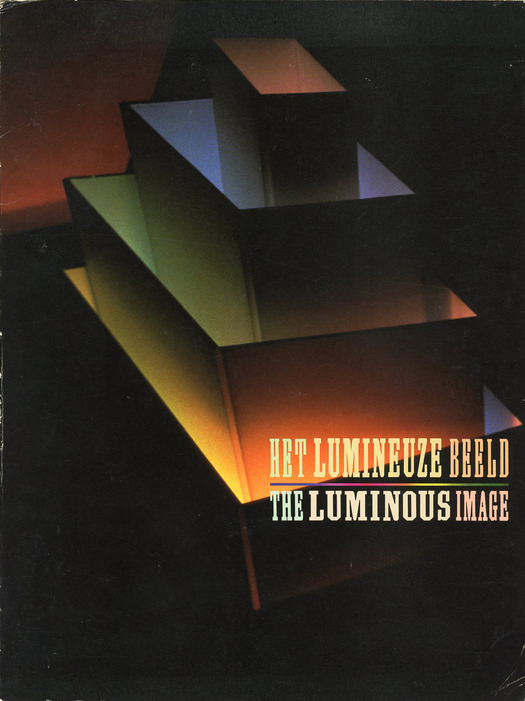
Catalogue for an exhibition of video art at the Stedelijk Museum, Amsterdam, 1984. The cover shows a work by Eno
Brian Eno: Visual Music, the first book devoted to Eno’s work as a visual artist, has recently been published by Chronicle Books. It reminded me of a profile I wrote for the British magazine Designers’ Journal in 1987, a year after the publication of More Dark Than Shark, a multimedia study of Eno, and the first book about him in English, for which I provided the text. There had been hundreds of articles about Eno in the music press, but at that point barely any in the art or design press that addressed his visual work in any detail — for the reasons discussed in my article. Designers’ Journal folded in the early 1990s and the piece has never previously appeared online.
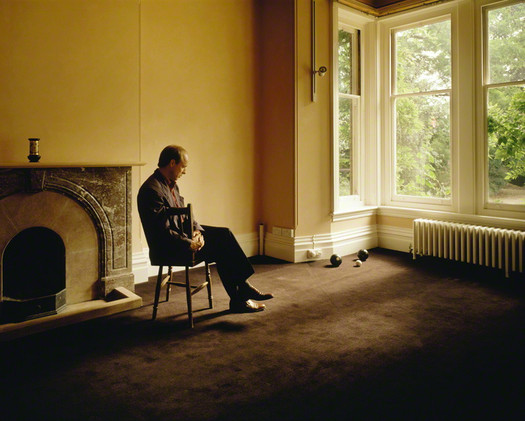
Brian Eno by Denis Waugh, 1987. Collection: National Portrait Gallery. A variant was used to accompany this profile
“I think there are some problems that are peculiarly English,” says Brian Eno with frustration. “I’ve noticed so often people say to me: ‘What do you do?’ And I say: ‘I’m a musician.’ They say: ‘That’s interesting.’ Then I say: ‘And an artist.’ And they go: ‘Oh . . .’ I can really detect a change of attitude. It’s ‘Oh, well, he’s not serious; if he does two things he’s not serious.’”
But Eno is entirely serious — in intention at least, if not in manner. It’s late afternoon and we’re sitting in his manager’s office on Harrow Road, London. He is clad in moody black from head to toe but his manner is relaxed, amiable and even chatty. The table is already scattered with the explanatory drawings and diagrams that accompany any dialogue with Eno. The famous sense of humor is in good working order. The suntan and the gold bracelet he wears on his wrist — an unexpected touch — exude wealth and vitality. Eno looks successful; he is successful.
All the more so, perhaps, when you consider that it is success on his own terms. Once, a long time ago, he was a pop star — a particularly wild and outrageous one. For two years, from 1971 to 1973, he played synthesizer with Roxy Music. He was an art school graduate (tutor: Tom Phillips) in the quintessential art-rock group. But he gave that up when he realized he could accomplish more in the wings than in the glare of the spotlight. He swapped the stage for the recording studio, cut his hair short and started to wear sensible shirts. He gave lengthy interviews in which he discussed (with enviable lucidity) the function of art as a an adaptational mechanism.
Taking his cue from Stafford Beer, a cybernetician, and the American writer Morse Peckham, Eno argued that: “Art is the exposure to the tensions and problems of a false world so that man may endure exposing himself to the tensions and problems of the real world” (Peckham). He did lecture tours. He founded a record label designed to introduce accessible experimental music at affordable prices. Slowly, the self-styled “non-musician” became “the prime theoretician of rock”; the “oblique strategist” became a “painter of sound.”
Now 39, Eno hasn’t let up. A restless energy seems to drive him. After a seven-year absence, during which he lived in New York and Paris, traveling continuously, he returned to England in 1985. He now lives in Woodbridge, Suffolk, where he was born.
In the past 14 years he has released 11 solo albums. There have been commissions for film and television music; collaborations with David Bowie, David Byrne and many others; production work for Talking Heads and U2; and, since 1979, more than 50 audiovisual installations around the world. If Eno is still to some degree a cult figure, an art school favorite rather than a household name, happier out of the limelight than in, it is a cult with international outposts. Cynical English commentators may tut-tut over his refusal to write any more songs, his arcane theories and his regrettable predilection for “ambient” music, but in Europe, Japan and North America they come with open minds.
The Italians, in particular, have warmed to his work. In the past two years, Eno has been invited to mount two audiovisual installations in Rome, two in Milan (including an entry at the Biennale in 1986) and one at Bari. An adventurous 24-speaker sound installation for Brunelleschi’s Ospedale degli Innocenti in Florence, built in 1419-45, has just been purchased. “Italians are thrilled by things that sit on the edge of categories,” says Eno. “We don’t buy art like Italians do. We don’t buy design like they do. We just don’t buy culture like they do.”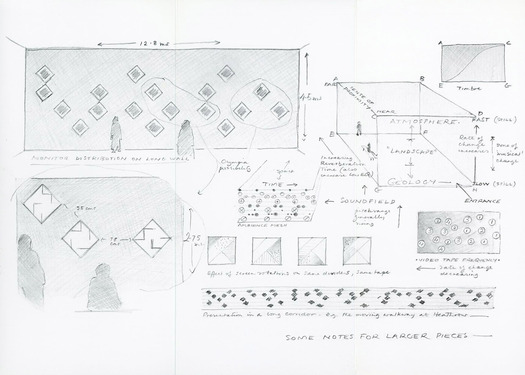 Sketches of video installation ideas by Brian Eno. Leaflet published by Opal Ltd, his management company, 1985
Sketches of video installation ideas by Brian Eno. Leaflet published by Opal Ltd, his management company, 1985
As if to prove his point, England has seen only two of his installations in the same period. The first, at the 2nd International Contemporary Art Fair at Olympia in 1985, was a small-scale, unsatisfactory affair. Noise from the show was a constant intrusion. The second, “Place # 11,” at the Riverside Studios, Hammersmith, in March 1986, was a much more successful fusion of music and imagery in a carefully controlled environment.
Visitors to the darkened gallery encountered card and Perspex structures suffused with slowing changing colored light generated by concealed video monitors. Some were translucent “paintings” like stained glass windows, rectangular or cross-shaped, composed of abstract lines and curves; others were three-dimensional sculptures that resembled lopsided skyscrapers or capsizing ziggurats. In the “Living Room,” a secret corner of the main installation, you could sit on a sofa and watch bars of iridescent light. As the colors flared into life, to gradate and fade, speakers in the far corners of the room relayed gentle electronic drones and radically decelerated melodies — a series of “unique sonic clusters,” endlessly repeating certain notes but never quite the same. It was a music without beginning (you always arrived part way through) and effectively without end (Eno’s tapes, slipping out of sync with one another, would have taken 68 weeks to run their course).
In these intensely beautiful installations the setting is active not passive. The environment is more than the sum of its parts; it is the experience. The Rothko room at the Tate Gallery [now Tate Modern], which Eno admires, is an obvious point of reference. If you were to take away any of the elements it would be incomplete. As a result, English critics can’t seem to decide whether Eno’s work is art, music or some mutant species of television.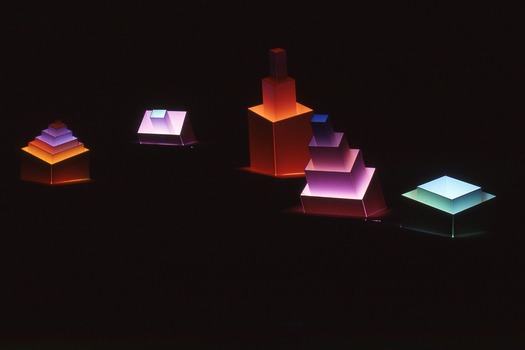
Brian Eno, video sculptures for “The Luminous Image,” Stedelijk Museum, 1984. Photograph: Tom Haartsen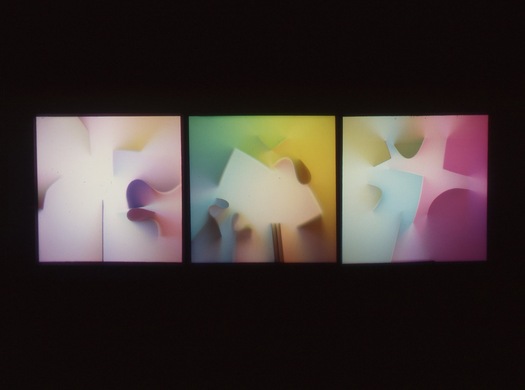
Brian Eno, video paintings for “The Luminous Image,” Stedelijk Museum, 1984. Photograph: Tom Haartsen
Time Out’s critic wrote off the Riverside show without bothering to review it; most of the others didn’t even do that. Certainly the neoteric world of video art has claims on his work. Internationally established artists like Nam June Paik and Bill Viola also use sound and TV imagery to construct a total environment. Eno’s recent work is new, however, in the way that it suppresses the screen, relegates it to the role of light source, banishing the connotations of ordinary television that bedevil so much video art. Art historians may also detect traces of Kandinsky, Malevich and Mondrian — those great spiritual abstractionists — in Eno’s pieces. Eno acknowledges these sources but remains uncertain how to classify his “works constructed with sound and light.” He hopes that someone expecting “fine art” won’t be disappointed but has no wish to present his shows that way.
“How I want to present them is more like, well . . . the circus comes to town,” he says smiling. “Because of our English tradition, if something is presented as fine art it’s a way of saying to a lot of people, ‘Don’t come.’ It’s the opposite of what I want to do. I want to invite people in, not to cut them out. I like it when these shows have a lot of people there and there’s a feeling in the room of people sitting quietly — that in itself is an interesting phenomenon.”
To experience Eno’s environments properly you have to give them time. Their effects are physical and cumulative. Once visitors adjust to their slow-moving rhythms, it’s not uncommon to stay as long as an hour, moving contemplatively from zone to zone. The installations are tranquil — they reduce stress and offer the kind of secular solace proposed by Peter Dormer — but accusations that they are tranquilisers are misplaced.
“It’s quite an unspecific feeling,” notes Eno. “When I leave there I feel really ready for something. I’m alive, alert in some way. I still get the feeling after I’ve seen so many of these things. I feel peppy and up; it’s actually a stimulant.”
Eno’s concern with environment and his use of music to promote physiological change go back to his earliest work. Another Green World (1975), his third album, is a remarkable evocation of landscape and place. Discreet Music, released the same year, found unexpected uses as a therapeutic tool in the treatment of handicapped children. But Music for Airports (1978) was the first recording he made with a specific public setting in mind. As the opening shot in a new “ambient” series, the album was virtually a manifesto. It’s a conception that owes something to Erik Satie’s “furniture music” (1917), which the eccentric composer urged his listeners to ignore, and a lot to the Muzak Corporation, founded in 1934.
Ambient music, Eno explained in a liner note, was to be an environmental music for the discerning listener. Like Muzak and other forms of canned music, it would operate in the background as an atmosphere or tint; but unlike Muzak, that much-derided medium, it would be interesting enough to sustain closer attention. The listener could come and go as he chose. Instead of “regularizing environments by blanketing their acoustic and atmospheric idiosyncrasies,” ambient music would enhance them. It would be calming in its effect but not anaesthetic. Thus Music for Airports’ gentle repetitions were intended to inure edgy travelers to the fear of flying. Airports in New York, Minneapolis and Berlin have so far risen to the challenge.
Encouraged, Eno has continued to explore the possibilities of ambient sound. On Land (1982), the third recording in the series, was “specifically dedicated to the idea of creating places in music.” It is perhaps the most complete expression yet of Eno’s vision of himself as a “landscape artist.” Natural sounds and echoes impossible in nature of up to 70 seconds evoke the locations documented in the track titles: “Lizard Point,” “Lantern Marsh,” “Dunwich Beach.” A proposal by the artist Russell Mills, Eno’s collaborator, to “install” the piece in the hills of the Lake District has not yet come to pass, however, and perhaps it never will. Hugely amplified, On Land’s seismic rumblings might sound like the wrath of God.
The proposal is not as bizarre as it sounds. In the USA (less so in the UK) environmental composition is an established genre in its own right. Since the 1960s, the composer Max Neuhaus — a sort of musical Christo — has conceived many bold environmental projects and his experiences point up the bureaucratic problems such work is bound to entail. It took Neuhaus four years to persuade the New York authorities to allow him to install sound-generating equipment beneath a grate in Times Square.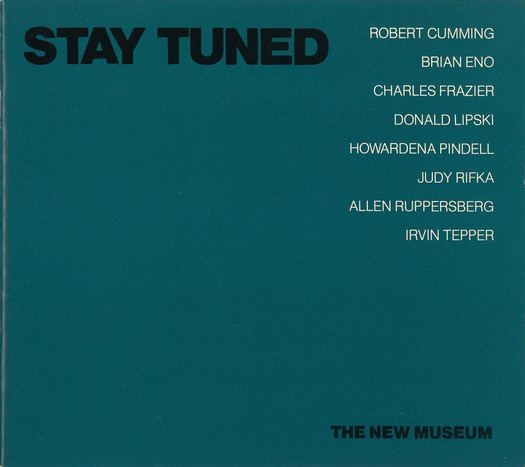
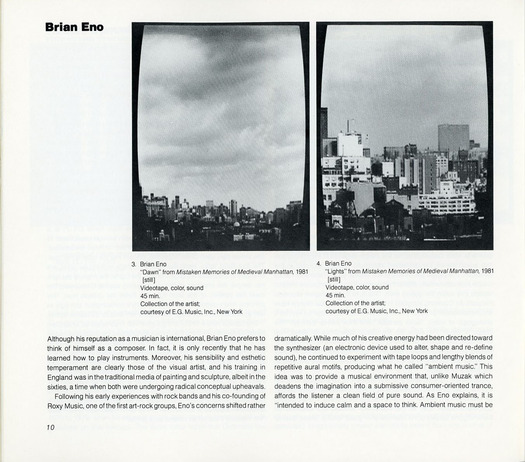
Catalogue for “Stay Tuned” exhibition of video art at The New Museum, New York, 1981
In 1979 Eno took his ideas about ambience a stage further. Using his own camera, he began to produce “non-narrative” videos much like gently animated paintings. At this stage you still watched an image on the screen but as with ambient music — used as a soundtrack — you could pay attention or wander off and do something else: exactly as you would with an ordinary painting. Showing characteristic disregard for convention, the vertical format of pieces like Mistaken Memories of Mediaeval Manhattan (1981) and Thursday Afternoon (1984) demands that the television be turned on its side. One of Eno’s most spectacular audio-visual installations to date, at Tokyo’s Laforet Museum in 1983, involved 36 such monitors and 42 speakers.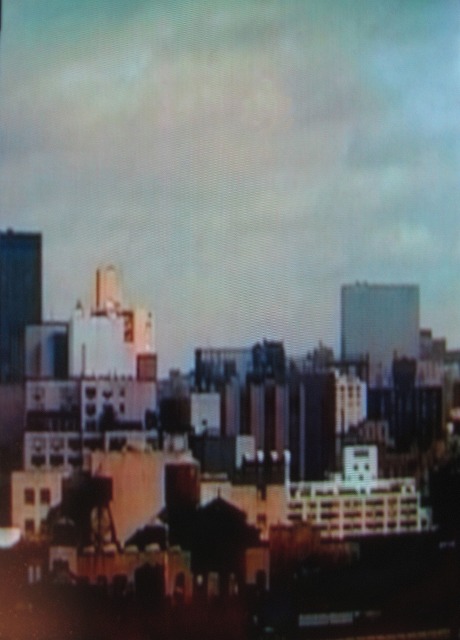
Still from Mistaken Memories of Mediaeval Manhattan, 45-minute video, shown vertically, 1981
Until now, in fact, few of Eno’s projects have been for the open air. But his most recent installation, a collaboration with the sculptor Andrew Logan for the Botanical Gardens in Rome (Italy again), suggests exciting possibilities for the future. As we talk through the project, his pencil skates across the paper in front of him, sketching locations and plotting sound relationships.
Logan, an old friend, has provided sculptural elements that range from a large “Cosmic Egg” to 25 “jewel-like” butterflies glinting in the greenery of the trees. “He’s another of those borderline cases where you don’t know if it’s fine art or fun art,” says Eno, who created the music, which emanates from 38 speakers concealed among the palms.
“I made these pieces so they relate to each other,” he explains, flourishing the pencil. “There’s a very interesting point here when you move from one to the next. This rather remote, warmish piece changes into one which is quite threatening. And there’s another element up here where I have a hybrid of the two. I’ve never tried anything like this before and I was really amazed that it works.”
Further hybrids, unforeseen by Eno but readily accepted (“Honour thy error as a hidden intention” is a long-held maxim), result at the points where two pieces of music intersect. “You just hear fragments — icebergs — starting to intervene,” he says. And if none of this appeals to the visitor there are, quite properly, areas of the garden where the music is inaudible. Eno plans to experiment further with the idea of “cross-breeding” musical pieces “so that you had not just two or three distinct identities but several, even eight or nine.”
Another project, planned for Bologna’s beautiful town square in 1988, will use more minimal musical resources. Inspired by a grid of 25 metallic-painted stones, which he and Logan devised for the Botanical Gardens, Eno hopes to create a similar, though much vaster, piece for Bologna’s old stone square. These rocks, possibly fake because of the weight, would be supported by metal rods. Each one would emit a single chord, its own resonant hum. “Can you imagine it?” Eno enthuses. “A number of really big rocks, floating and quivering in the sky.”
It may never happen: playful speculation is Eno’s stock in trade. Moving at a tangent to his stated goal has become a modus operandi. He is just as likely to do something else, as yet unimagined. But it looks increasingly like another project, the long-cherished “Quiet Club,” will come about. This would be a permanent installation along the lines of the Riverside show, a place of contemplation and quiet, financed by a pay-at-the-door policy or annual membership. Eno has been talking to estate agents about sites in west London or the East End of 3,000 to 5,000 square feet. There are also plans for Quiet Clubs in Paris and Frankfurt.
“I keep thinking about discotheques,” he says. “They have the wrong ambience but they are the right kind of place. Imagine if there were clubs you could go to which were as designed as discos and as carefully thought-out in terms of decor and stimulus, presentation and music — that had that level of attention — but did other things. So the result they produced in you was different.”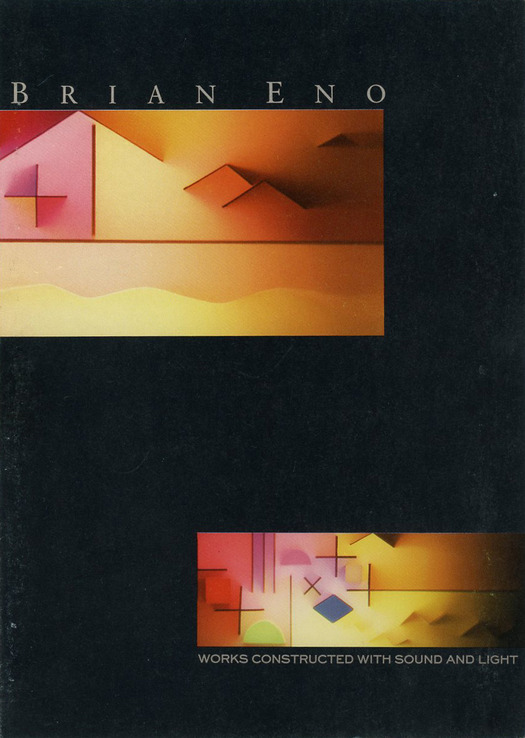
Cover of leaflet published by Opal Ltd, 1986. Design by Russell Mills
Eno’s approach to art was forged in the heady experimentalism of the 1960s. Like much art of that period, which was as interested in the social processes that generated a work as in the product itself, Eno is concerned with the audience and its response. “The fact that people behave in a different way at my exhibitions — that, for me, is of tremendous conceptual interest,” he says. At the same time, craft has become increasingly important to him. Intuition, the creative use of chance and a willingness to take risks are backed up by a formidable mastery of recording studio technique and a probing, analytical mind.
If the Quiet Clubs succeed, then it is possible to envisage even more novel applications for installations of this kind — outside and inside, in corridors, rest rooms, reception areas and the home. Eno’s work is important precisely because it pushes at the boundaries of what musicians, artists and designers do.
Recently he went to see Gilbert & George’s exhibition at the Hayward Gallery. This is art for the people with a vengeance and, sure enough, the show has been pulling in the crowds. But Eno doubts that visitor satisfaction — the one issue that art criticism consistently fails to address — is very high. “To me,” he says, “it’s no more interesting than the Harrods Christmas sale if people didn’t feel anything special.” This is the crucial test and Eno’s art has this power.
This article was first published in Designers’ Journal, October 1987, under the title “Brian Eno: Landscape Dreamer.” Some small edits have been made. The illustrations are from items in the collection of Rick Poynor, except where noted.
See also:
Where is Art Now?
Design a Cover for Eno’s Music for Films

